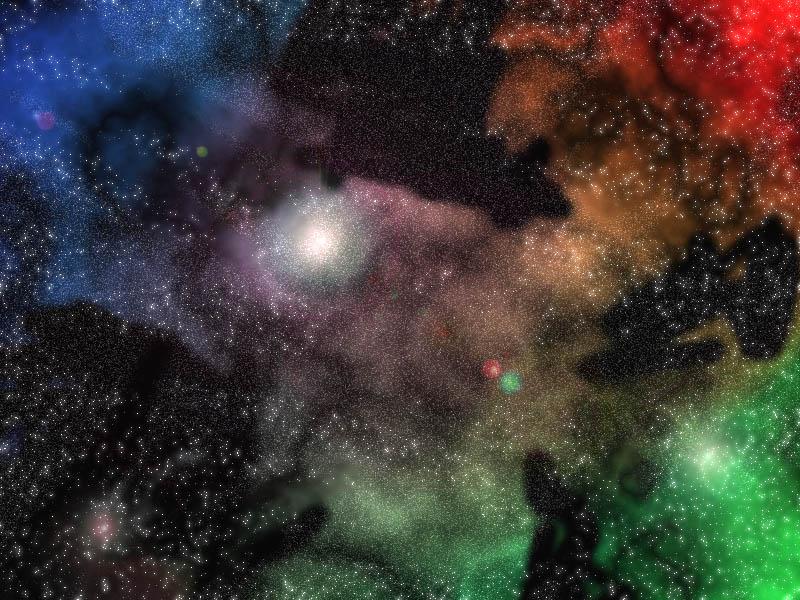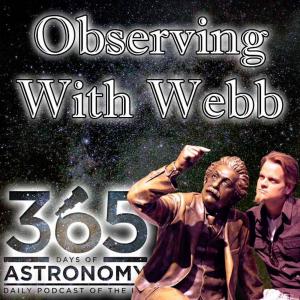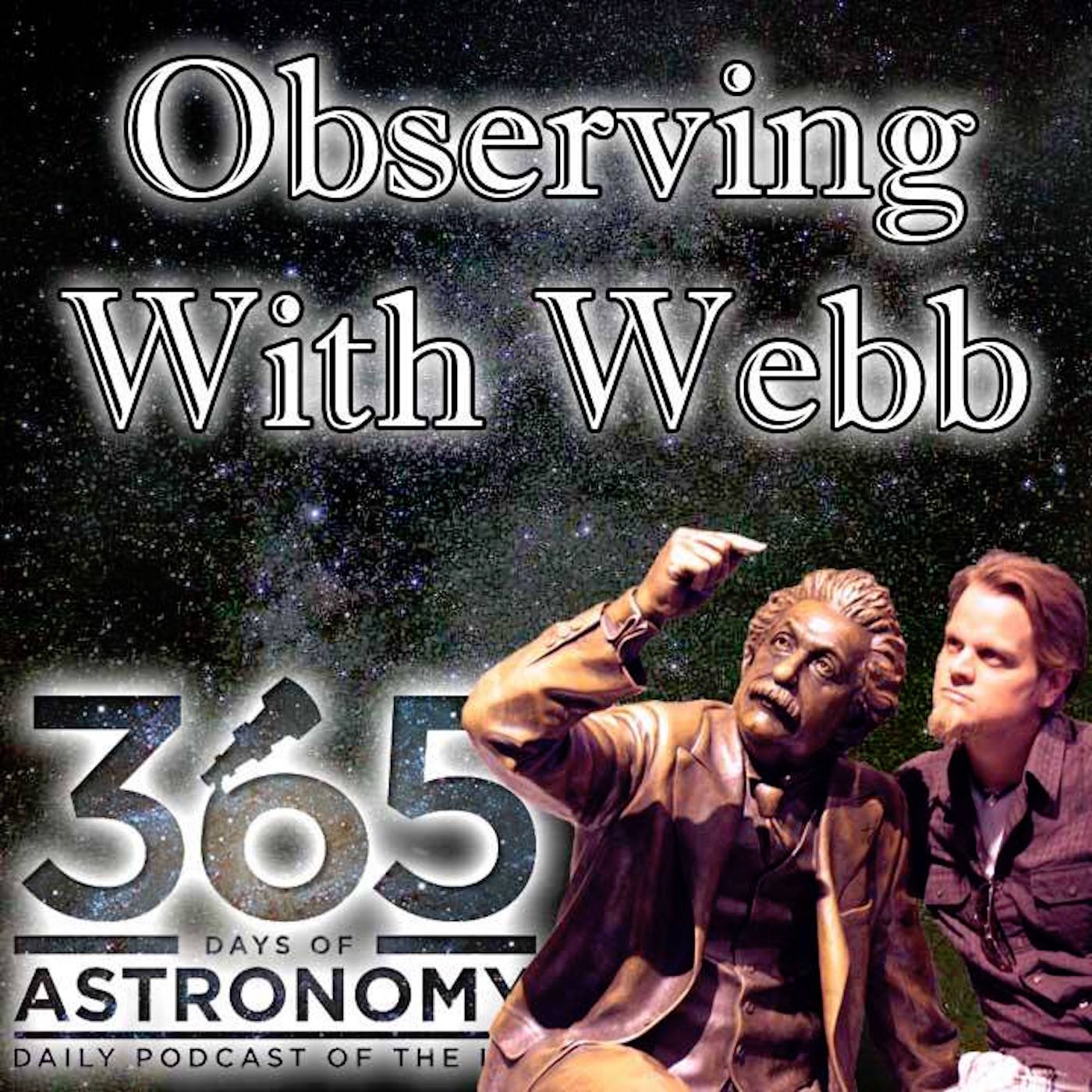Episodes

Monday Apr 30, 2012
May 2012 (plus a little bit o' June)
Monday Apr 30, 2012
Monday Apr 30, 2012
May 2012 is less exciting month for the casual observer on the east coast, however there are a few special events for those of you in the western US to take in that I'll touch on a little bit here. Other than that, here are the events, planets, and constellations for the month of May, plus some advance planning for a big event in June. EVENTS...
4th - Close Encounter - Moon & Saturn - Look to the SE after 8pm and find the full Moon rising. Saturn will be the bright object about 7˚ above the Moon. Spica, Virgo's brightest star, is a little closer to the Moon, and to the right.
Full Moon - 5th (Visible all night - East around sunset, West around Sunrise) - biggest full Moon of 2012 (not by much though)
Last Quarter Moon - 12th (Visible from midnight into the morning)
New Moon - 20th (darkest skies)
20th - Annular Solar Eclipse - Basically if you're within 50-100 miles of the Atlantic Ocean, you're out of luck, but the rest of country gets to witness an Annular Solar Eclipse, or at least part of it, this afternoon. Sky and Telescope and NASA both have good websites with more information. The further west you are, and the closer you are to the annularity path, the more of the eclipse you'll see.
22nd - Close Encounter - Moon & Venus - Look to the West after sunset and you'll see Venus about 5˚ to the right of a very thin crescent Moon.
22nd - Lunar Occultation of Zeta Tauri - So you have to be either on the west coast or in the middle of the country to see this, but if you're there. The tables of data are here.
First Quarter Moon - 28th (Visible until midnight)
28th - Close Encounter - Moon & Mars - Go out after sunset and find the First Quarter Moon in the SW. Mars is about 8˚ (the width of one fist at arm's length) above the Moon. Look for the reddish object in Leo. Watch them move toward the West throughout the night and set around 1am.
31st - Close Encounter - Moon & Saturn - Look to the S after 8pm and find the waxing gibbous Moon. Saturn will be the bright object about 7˚ above the Moon. Spica, Virgo's brightest star, is much closer to the Moon.
June 5th - Transit of Venus - Get ready for the Transit of Venus! If you've noticed a very bright object in the Western sky after sunset the past couple months, you have probably been looking at Venus - right now it's the brightest object in that area. Between now and June 5th, you'll see it lower and lower in the sky at sunset, getting closer to the Sun. On June 5th, starting around 6:09pm Eastern Daylight Time, Venus will cross directly in front of the Sun (called a "transit"). We will be able to observe the first 2.5 hours of the nearly 7-hour long event, since the Sun sets around 8:30pm. This is almost truly "once-in-a-lifetime" (it happened in 2004, but will NOT happen again until 2117). NASA has a good site with LOTS of information, plus PV will be hosting an event.
PLANETS...well, the ones visible with your naked eye Planets you can see around Sunset -Venus (W), Mars (SW), Saturn (SE) Planets you can see throughout the night - Mars (SWàW), Saturn (SEàW) Planets you can see in the Morning - NoneMercury - Not worth looking for this month
VENUS - In the beginning of the month Venus will be about 30˚ (three fist-widths) above the western horizon at sunset, and in a slightly crescent phase (if you look through a telescope, maybe binoculars). Throughout the month, it will lower and lower at sunset and be in a more crescent phase (and get bigger). Close to the Moon on the 22nd.
MARS - In the SW after sunset, and sets around 2am. Look for the constellation of Leo and look for the reddish hued point of light right in the middle - use a star chart to help. Close to the Moon on the 28th.
Jupiter - Not visible this month, but will cross over into the morning sky in June.
SATURN - Already up in the SE at sunset and setting in the west around 4am. Saturn will be up to 40˚ above the southern horizon at 10pm. Near the Moon on the 4th and 31st.
CONSTELLATIONS... (see sky map link at the bottom for a Star Map for this month - or ask Mr. Webb) Look straight up and you'll see...After Sunset (sunset is between 8:00pm and 8:30pm) - Ursa Major's legs, Leo, Leo Minor - Extra Challenge! See if you can find M3 (Messier Object #3) using your binoculars. It's a bright globular cluster with 500,000 stars. It'll be a bright-ish hazy spot. A telescope will bring out even more detail. Use a skymap from skymaps.com to help you find it.
Midnight - Bootes - find the Big Dipper's handle, and starting from the inside of the handle, follow the arc that those four stars make past the last star in the handle about 30˚ or three fist-widths to the next very bright star you find which is Arcturus, the base of the constellation Boötes. Hence astronomers use the phrase "Follow the Arc to Arcturus"
Early Morning - Hercules, Lyra, Cygnus - These are the Summer constellations, and since they are starting to rise in the morning now, that means that summer is on its way.
GENERAL CONSTELLATION FINDING TIPS:Spring constellations: Bootes, Virgo, Leo, Corona Borealis, Hercules.
First find the Big Dipper in the North (a North Circumpolar Asterism that never sets) and look at the handle. Starting at the star closest to the "cup" part, follow the rest of the stars in the handle and follow the arc to Arcturus. Arcturus is the brightest star in Bootes the Shepherd. Some say he looks more like a kite, others say more like an ice cream cone.
Then, following the same "arc", speed on to Spica. Spica is the brightest star in Virgo. Virgo's a dimmer constellation, so you'll be rewarded when you find her.
To the left of Bootes is Corona Borealis. This is a small collection of stars that make a crown, cup, or U shape in the sky.
To the left of Corona Borealis is the great constellation of Hercules. Hercules is the Hero of the sky and has a central "keystone" asterism, in which lies M13, the Hercules Cluster.
Lastly, Leo is a constellation consisting of a backward question mark (or sickle) and a right triangle to the left. Use the two Big Dipper "cup" stars that are in the middle of the Big Dipper and follow the line they make to the bright star Regulus, the brightest star in Leo.
Use a sky map from www.skymaps.com to help you out.
Saturday Mar 31, 2012
April 2012
Saturday Mar 31, 2012
Saturday Mar 31, 2012
April 2012 is for naked eye observing, since Venus, Mars, and Jupiter are all up after sunset for the whole month, a meteor shower greets us mid-month, and there are plenty of close encounters. It wouldn't hurt to bring a camera with you though. EVENTS...
2nd, 3rd - Close Encounter - Venus & Pleiades - Venus will pass right by the Seven Sisters these two nights making this a great opportunity for photographers
3rd - Close Encounter - Moon & Mars - Go out after sunset and find the Gibbous Moon in the SSE. Mars is about 10˚ (the width of one fist at arm's length) above the Moon. Look for the reddish object in Leo. Watch them move toward the West throughout the night and set around 4am.
Full Moon - 6th (Visible all night - East around sunset, West around Sunrise)
7th - Close Encounter - Moon & Saturn - Look to the SE after 10pm and find the Full Moon rising. Saturn will be the bright object about 7˚ above the Moon. Spica, Virgo's brightest star, is in the middle between the Moon and Saturn.
Last Quarter Moon - 13th (Visible from midnight into the morning)
New Moon - 21st (darkest skies)
21st - 22nd - LYRID METEOR SHOWER - The Lyrids aren't really a strong meteor shower, but at least it's warmer out than in the Fall (hopefully). This year is especially good, since the New Moon won't interfere with visibility. There are typically only 10-20 meteors per hour, so be patient. The best time to look is midnight on into the morning of the 22nd. Here's the typical advice for watching a meteor shower:
Find a dark location, and lie down in a reclining chair or swimming pool floaty
Dress in multiple layers and bring hot chocolate
Check the weather to see if the skies will be clear (weather.com has a good map here)
You want to look at the sky as a whole rather than looking at one spot or through a telescope or binoculars. You never know where in the sky they will be.
But you DO know where they will come from - Lyra! Look toward Lyra (In the NNE close to the horizon around 10pm, rises throughout the night until sunrise where it will be almost directly above.) That is where the radiant is - where the meteors will appear to be coming from. If you trace the meteors' steps back, they should all go to that spot.
Adapt your eyes to the dark by staying away from light sources or using a red light if you need to look at a star chart or not trip over something.
The shower is usually active from April 16th to April 25th, but it peaks on the 22nd. You may see a few stray Lyrids in the days leading up to and after the peak as well.
22nd - Close Encounter - Moon & Jupiter - Look low in the West after sunset. The thin crescent Moon will be less than 3˚ above Jupiter. Brilliant for pictures with zoom lenses.
23rd - Close Encounter - Moon & Pleiades - Look to the West after sunset. The thin crescent Moon will be less than 5˚ to the left of the Pleiades. Brilliant for pictures with zoom lenses.
24th - Close Encounter - Moon & Venus - Look to the West after sunset and you'll see Venus about 6˚ to the right and up from the crescent Moon.
First Quarter Moon - 29th (Visible until midnight)
30th - Close Encounter - Moon & Mars - Go out after sunset and find the Gibbous Moon in the S. Mars is about 9˚ (the width of one fist at arm's length) above and to the left of the Moon. Look for the reddish object in Leo. Watch them move toward the West throughout the night and set around 3am.
PLANETS...well, the ones visible with your naked eye Planets you can see around Sunset -Venus (WSW), Jupiter (W), Mars (SE) Planets you can see throughout the night - Mars (SEàW), Saturn (EàW) Planets you can see in the Morning - Saturn (W)Mercury - Not worth looking for this month
VENUS - Look toward the West after sunset. From now until May, Venus will be very prominent, then quickly get lower and disappear by the end of May. If you're looking with your naked eye, it is the brightest object about 30˚ or more (three fist-widths) above the western horizon. Below the horizon after 10:00pm. Close to the Moon on the 24th right after sunset toward the West. If you're looking through a telescope at dusk, you may see it in its half-lit phase in the beginning of the month and more crescent like toward the end of April.
MARS - April is a great time to look at Mars - it's up pretty much all night. In the SE after sunset, the South later in the night, and West in the very early morning. Look for the constellation of Leo and look for the reddish hued point of light right in the middle - use a star chart to help. Close to the Moon on the 3rd and the 30th.
Jupiter - About 30˚ above the Western horizon right at sunset at the beginning of the month, but is just barely above the Western horizon at sunset at the end of the month. Close to the Moon on the 22nd. Won't be visible all next month.
SATURN - Rising in the ESE around 9pm and setting in the west around sunrise. Saturn will be up to 40˚ above the southern horizon at 1am. Near the Moon on the 7th.
CONSTELLATIONS... (see sky map link at the bottom for a Star Map for this month - or ask Mr. Webb) Look straight up and you'll see...After Sunset (sunset is around 7:30-8:00pm) - Cancer, Leo, Lynx, Ursa Major's legs - Extra Challenge! Find M44 in the Middle of Cancer - an open cluster of stars also known as the Beehive Cluster. You may be able to see it as a small fuzzy patch with your naked eye if you have very dark skies. However with a pair of binoculars or a telescope on low power, it will look like a hive of bees in the distance, hence its nickname.
Between Sunset and Midnight - Leo, Leo Minor, Ursa Major's legs
Midnight - Canes Venatici, Coma Berenices are closer to the Zenith (the point straight above you), but Ursa Major, Leo, and Bootes make a nice but bigger triangle around it.
Early Morning - Hercules, Lyra, Cygnus - These are the Summer constellations, and since they are starting to rise in the morning now, that means that summer is on its way.
GENERAL CONSTELLATION FINDING TIPS:Winter constellations: Orion is still easy to spot as he is directly in the SW after sunset. You can use Orion to find many other winter constellations, for the last time until the fall.
Using Orion: Find Orion by looking for the three stars in a row that make up Orion's belt in the Southwest. If you draw a line from the left star to the right star and keep going right about 20 degrees (about 2 fists at arm's length) until you reach another very bright star, you will have reached the star Aldebaran in Taurus (the V). Follow that line a little more (about another fist) and you'll find the Pleiades.
If you start at his belt again, but instead go the opposite way and draw a line from the right star in Orion's belt to the left star, and keep going left about 20 degrees (2 fists again), you'll come to the brightest star in the sky - Sirius - part of Canis Major.
Above these three constellations are Gemini and Auriga. The brightest stars in each of these constellations form a circle in the sky. Going clockwise - Aldebaron (Taurus) - Rigel (Orion - bottom right foot) - Sirius (Canis Major) - Procyon (Canis Minor) - Castor & Pollux (Gemini) - Capella (Auriga). It makes for great stargazing in the winter sky.
Use a sky map from www.skymaps.com to help you out.
